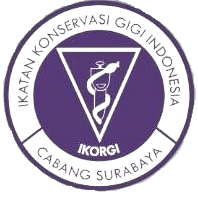Efek Antibiofilm Glass Ionomer Cements dan Resin Modified Glass Ionomer Cements Terhadap Lactobacillus acidophilus
Downloads
Background: Risk factors for developing secondary caries are similar to those resulting in primary caries. The marginal seal of a restoration is one of the important factors predicting clinical success. The antibiofilm effect of materials used for the luting cement of oral function affects oral health. Antibiofilm properties of dental luting materials such as Glass Ionomer Cement (GIC) and Resin Modified Glass Ionomer Cement (RMGIC) may improve the restorative treatment outcome. Purpose: This experiment evaluates the antibiofilm effect of GIC and RMGIC on Lactobacillus acidophilus in vitro. Method: Lactobacillus acidophilus served as test microorganism. The quantitative microtiter plate biofilm assays were used to evaluate the antibiofilm effect of the dental luting materials on early-stage biofilm using a direct contact test (DCT) then continued by reading of Optical Density (OD) of biofilm using ELISA reader at a wavelength of 570nm. Result: GIC and RMGIC showed a decrease of OD value from negative control in all groups. The materials' elute had effect on both bacterial growth with GIC higher then RMGIC to inhibit Lactobacillus acidophilus biofilm formation. Conclusion: The antibiofilm effect of GIC more effective than RMGIC to inhibit Lactobacillus acidophilus biofilm formation.
Klai S., Markus A., Bettina, S., Annette, A., Elmar, H., dan Ali, A., Antimicrobial Effect of Dental Luting Glass Ionomer cements on Streptococcus mutans. Journal of Scientific world 2014; 1-7.
N. Hí¸iby, T. Bjarnsholt, M. Givskov, S. Molin, and O. Ciofu., "Antibiotic resistance of bacterial biofilms” International Journal of Antimicrobial Agents 2010; 35(4): 322–332.
Jiang, X. Investigation of Antibacterial Properties during Hardening of Dental Cements. Degree project in applied biotechnology, master of science. Uppsala universitet; 2011.
Byun, R., Nadkarni, M. A., Chhour, K. L. & Martin, F. E., Quantitative Analysis of Diverse Lactobacillus Species Present in Advanced Dental Caries, J Clin Microbiol 2004; 42(7), 3128-31.
Marks, DW., Biokimia kedokteran dasar: sebuah pendekatan klinis. Jakarta: EGC; 2000.
Babar MG., Lin SL., Cariostatic Effect of Fluoride-containing Restorative Materials: A Review. Malaysian Dental Journal 2009; 30(2) 130-136.
Fejerskov O, Edwina K., Dental Caries: The Disease and its Clinical Management Second Edition. Blackwell Publishing: UK; 2008. p.166
Bradshaw DJ, Marsh PD, Hodgson RJ, Visser JM., Effects of glucose and fluoride on competition and metabolism within in vitro dental bacterial communities and biofilms. Caries Research 2000; 36: 81"6.
Subiyanto A. Daya antibakteri semen gelas ionomer tipe perekat dan tumpatan terhadap Streptococcus mutans. Majalah Kedokteran Gigi (Dental Journal) 2002; 35(93):111–3.
Itota T, Carrick TE, Yoshiyama M, Mccabe JF., Fluoride release and recharge in giomer, compomer and resin composite. Dent Mater 2004; 20:789-95.
Basso GR, Bona ÁD, Gobbi DL, Cecchetti D., Fluoride Release from Restorative Materials. Braz Dent J. Vol 2011; 22(5): 355-358.
Hatrick CD, Eakle WS, and Bird WF., Dental Materials: Clinical Applications for Dental Assistants and Dental Hygienists. Sunders: Elsevier's Health Sciences; 2003, p.73-183.
Beyth N, Domb AJ, Weiss EI, An in vitro quantitative antibacterial analysis of amalgam and composite resins. Journal of dentistry 2007; 35: 201-06.
Wiegand A., Buchallaa W., Attina T., Review on fluoride-releasing restorative materials”Fluoride release and uptake characteristics, antibacterial activity and influence on caries formation. Dental materials 2007; 23 (3):343–362.
Van Noort R. Introduction to dental materials. 2nd ed. USA: Mosby-Year Book, Inc; 2003. p.124-139.
Marquis RE, Clock SA, Mota-Meira M., Fluoride and organicweak acids as modulators of microbial physiology. FEMS Microbiol Rev 2003; 26:493-510.
Svensäter G, Sjögreen B, Hamilton IR., Multiple stress responses in Streptococcus mutans and the induction of general and stressspecific proteins. Microbiology 2000; 146(Pt 1):107-117.
Nicholson JW., Fluoride-Releasing Dental Restorative Materials:An Update. Balk J Dent Med 2014; 18: 60-69.
Mount GJ., An Atlas of Glass Ionomer Cements: Clinician's Guide. 3rd ed. London: Martin Dunitz; 2002. p. 3-7.
Anusavice, K.J. Phillips' Science of Dental Materials, 12th ed. Elsevier Saunders, Missouri; 2013. p. 63-5, 93-4, 100-4, 107-8, 474-482.
Mount GJ, Hume, WR., Preservation and restoration of tooth structure. Australia: Watts; 2005. p. 163-96.
Al Naimi OT, Itota T, Hobson RS, Mccabe JF, Fluoride release for restorative materials and its effect on biofilm formation in natural saliva. J Mater Sci: Mater Med 2008; 19:1243–1248.
Hegde MN, Shetty AV., Fluoride Release From Three Different Glass Ionomer Cements In De-Ionised Water-An In Vitro Study. Universitas Journal Of Pharmacy 2013; 2 (6): 47-51.
Zafar MS., Ahmed N., Therapeutic Roles Of Fluoride Released From Restorative Dental Materials. Research review Fluoride 2015; 48(3)184-194.
Dionysopoulos D. The Effect Of Fluoride-Releasing Restorative Materials On Inhibition Of Secondary Caries Formation. Research review Fluoride 2014; 47(3):258–65.
Kiran A., Hegde V., A short term comparative analysis of Fluoride release from a newly introduced Glass Ionomer Cement in deionised water and lactic acid. J. Int Oral Health 2010; 2 (2): 71-7.
Carey CM, Spencer M, Gove R., Eichmiller., Fluoride release from resin-modified glass ionomer cement in a continuous flow system. Effect of pH. J Dent Res 2003; 82(10): 829-32.

CDJ by Unair is licensed under a Creative Commons Attribution 4.0 International License.
1. The journal allows the author to hold the copyright of the article without restrictions.
2. The journal allows the author(s) to retain publishing rights without restrictions










